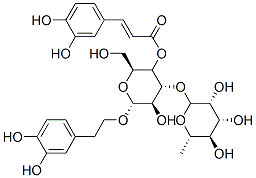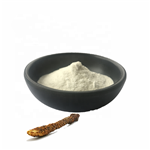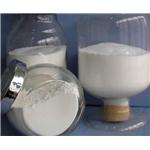Verbascoside is isolated from Lantana camara, acts as an ATP-competitive inhibitor of PKC, with an IC50 of 25 µM, and has antitumor, anti-inflammatory and antineuropathic pain activity.
Verbascoside can be found in species in all the families of the order Lamiales (syn. Scrophulariales). Only two examples are known from outside the order,in the clade Asterids.
It is known, that amyloid fibrils accumulation in cerebral can easily lead to neurodegenerative disorders. Acteoside has been reported to inhibit Aβ42 aggregation by activating nuclear translocation of the transcription factor NF-E2-related factor 2 (Nrf2), increasing heme oxygenase-1 (HO-1) expression. It has also been shown that acteoside could decrease nitric oxide synthase (NOS) activity and caspase-3 expression.
Verbascoside is an agent producing effects on anti-GBM nephritis in rats. Effective agent against glomerulonephritis. Phenolic anti-oxidant agent.
ChEBI: Acteoside is a glycoside that is the alpha-L-rhamnosyl-(1->3)-beta-D-glucoside of hydroxytyrosol in which the hydroxy group at position 4 of the glucopyranosyl moiety has undergone esterification by formal condensation with trans-caffeic acid. It has a role as a neuroprotective agent, an antileishmanial agent, an anti-inflammatory agent, a plant metabolite and an antibacterial agent. It is a cinnamate ester, a disaccharide derivative, a member of catechols, a polyphenol and a glycoside. It is functionally related to a hydroxytyrosol and a trans-caffeic acid.
Verbascoside has anti-inflammatory and photoprotective properties. It has shown neuroprotective effects on PC12 neuronal cells against neurotoxicity. Verbascoside is proven to be a potent inhibitor of xanthine oxidase (XOD) in in vitro studies.', 'Phenylethanoid glycoside. Antioxidant and antiproliferative.
This plant glycoside and antioxidant (FW = 624.60 g/mol; CAS 61276-173), also known as verbascoside, inhibits TNFa-mediated apoptosis in LPSstimulated macrophages as well as 1-methyl-4-phenylpyridiniuminduced apoptosis in cerebellar granule neurons. It also inhibits proliferation of human promyelocytic HL-60 leukemia cells by inducing cell cycle arrest at the G0/G1 phase, followed by differentiation into monocytes. Acteoside inhibits PMA-induced invasion and migration of human fibrosarcoma cells by Ca2+-dependent CaMK/ERK and JNK/NFκB-signaling pathways. Acteoside thus shows the potential as antimetastatic agent. Another intriguing finding is that acteoside inhibits amyloid-β aggregation. Target(s): aldose reductase; protein kinase C; integrase, HIV-1; peptidyl-dipeptidase A, or angiotensin-converting enzyme; tyrosinase, or monophenol monooxygenase; 5-lipoxygenase, or arachidonate 5-lipoxygenase.



